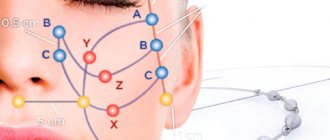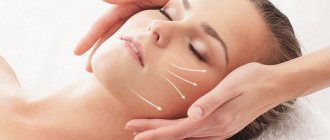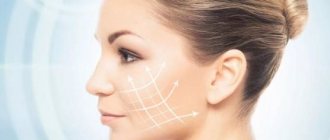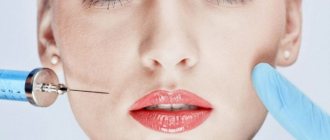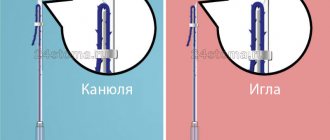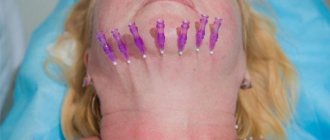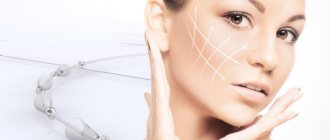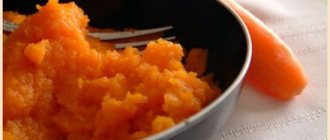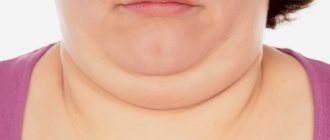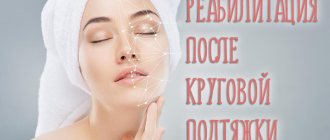Face lift threads are one of the most advertised procedures in the field of cosmetology and plastic surgery.
This lifting is positioned not only as safe and gentle, but also as an effective method of tightening the skin in order to give the face the desired contours.
Moreover, the results from the use of threads are comparable to the results after plastic surgery.
To understand whether this is so, it is necessary to carefully study the features of this lifting method and weigh all the pros and cons.
What is a thread lift?
In certain areas of the face, threads made of material biologically compatible with the human body are introduced under the patient’s skin according to a special scheme.
They create a strong frame, thanks to which the necessary relief is recreated, and wrinkles and creases are smoothed out.
This method of rejuvenation, as a rule, is used in cases where more gentle methods (resurfacing, biorevitalization, mesotherapy, etc.) no longer work, and the face is rapidly aging.
But threads are unlikely to help women aged 50 years and older; at this age it is better to think about other methods.
But patients under 35-40 years old can achieve excellent results, which are visible to the naked eye, but do not need to go under the surgeon’s scalpel.
Frequent mistakes and failures of thread lifting. Why do they happen
When deciding to carry out such procedures, what you should first pay attention to:
- Unsanitary conditions : poor sterility of equipment and instruments, carrying out a lifting operation in a room not intended for such work is simply unacceptable.
- Insufficient qualification of a specialist can lead to the operation being carried out with violations of the insertion technique, excessive tension of the thread, which can cause stretch marks, folds or bunching of the skin.
- Lack of asepsis and antisepsis before and during the lifting procedure, which leads to infection of soft tissues and the formation of inflammation.
- Patient predisposition : an experienced and qualified cosmetologist is required to collect a detailed medical history,, if necessary, request the results of some tests and give good advice.
Blindly pursuing a goal just to achieve the result of rejuvenation at any cost is the main mistake.
Only by arming yourself with detailed information and going through all the necessary preoperative steps can you minimize the risk of an unsuccessful outcome.
Read the popular article in the section about the product: Black facial skin cleansing mask: how to make a black mask at home. Recipe, application, reviews.
Types of threads
Since the facial structure of different people has characteristics, and age-related changes are expressed differently, cosmetologists and plastic surgery specialists use several types of threads.
In each case, their specific type is selected by the doctor. Let's look at the most popular ones.
Smooth (non-absorbable)
Consist of silicone, polyurethane and polyamide fibers. They feature an absolutely smooth surface. They do not dissolve.
These threads are designed for working with deep layers of skin. They are arranged in the form of a loop and are fixed to the bone tissue of the face, therefore they guarantee a serious lift even in cases of severe ptosis.
The method of their introduction is more complex than the others, since in some cases it requires a small incision of the skin.
Mesothreads
They are the thinnest of the absorbable types. The advantage of their introduction is that it is minimally traumatic, since a special blunt-tipped needle (cannula) does not pierce the soft tissues, but pushes them apart.
The downside of these features is that the introduction of mesothreads requires a high level of professionalism, experience and accuracy of each movement from the doctor, since the slightest mistake can lead to tightening of the skin and deterioration of the appearance of the face.
Mesothreads completely dissolve after 6 months from the moment of installation, but during this time they are overgrown with a framework of collagen fibers.
Their supporting effect lasts approximately 2 years (although some experts are skeptical about this period).
This type of thread should be installed in patients aged 30-40 years, since in case of severe sagging they will not work properly.
Aptos threads
They have special notches that help the frame to better secure itself in the tissues. They are located under the skin at a depth of 3-5 mm and are introduced through punctures in the skin.
There are different variations of Aptos products. For example, “hammocks” are designed specifically to eliminate a double chin, and “springs” are designed to combat nasolabial folds and sagging cheeks.
A popular product today is the new line of Excellence Visage threads. They are made from completely biodegradable polylactic acid, which is excreted from the body 12 months after the procedure.
Aptos Excellence Visage threads guarantee significant skin rejuvenation immediately after the procedure. With their help you can correct the following defects:
- drooping upper eyelids and “sad” eyebrows;
- severe ptosis on the cheeks and chin;
- deep wrinkles and creases in the skin on the face and neck;
- nasolabial folds.
The effect of use can last from 3 to 6 years.
Cone-shaped combination threads
They are made from degradable polypropylene and have about 8-11 knots and cones of glycolide and lactic acid copolymer throughout the thread.
The last two materials dissolve and at the same time stimulate the formation of connective tissue, which subsequently guarantees the effect of tissue tightening. Such combined threads are used to correct the oval of the face and tighten skin that has lost its tone.
The disadvantage is that the rehabilitation period is quite unpleasant: the swelling may not go away from the face for a long time, and during the first month the patient is not recommended to smile.
Golden threads
Gold is a hypoallergenic material; in addition, it is time-tested, because gold “threads of beauty” began to be used long before the development of modern options.
Such threads include two components: polyglycol and gold. The latter, in the form of a thin shell, is wound onto a conductor made of synthetic material.
This frame stimulates collagen production and is covered with a sheath of connective tissue. But a significant disadvantage of using gold is the inability to use the services of hardware cosmetology in the future.
In addition, with a sharp change in ambient temperature, the skin noticeably changes color.
List of possible problems
Complications after threads on the face can develop as a continuation of the natural consequences of the intervention. If bruises and swelling do not disappear for a long time, but on the contrary, increase their presence, this is already a reason to visit a doctor and take additional measures. Among the consequences of thread lifting, there are such signs that under no circumstances are considered normal and in most cases force the removal of threads:
- Allergy . Intolerance and resulting poor health can be caused by painkillers or other medications used during the intervention. Less commonly, a reaction occurs to the threads themselves. Allergies to drugs are detected quickly. Rejection of the material occurs some time after completion of the procedure.
- Infection . If inflammation is detected at an early stage and does not occupy a large area of tissue, it can be treated with antibiotics. If an abscess develops, the threads must be removed.
- Persistent impairment of facial expressions . It can be caused by injury or compression of the nerves, which is very rare. Then the threads should be removed.
- Violation of the facial contour . It occurs as a result of overcorrection when tissue is tightened too much. Massage can help with some threading techniques.
- Changing thread locations . This happens more often when using smooth material. Mesothreads and gold can also cause complications.
- Translucent support material . This happens when the technique of introducing threads is incorrect. If they are laid too close to the surface of the skin, the lines of the frame will clearly appear on it.
- Dents at the needle entry and exit points . This complication is difficult to predict. But you can fight it if you slightly peel off the skin at the problem point (this is done by a specialist).
Examples of thread lifting:
Bruises from mesothreads
The formation of bruises from mesothreads is a normal side effect that does not require medical intervention. Such subcutaneous hematomas are small in size, begin to change color and disappear after 2-3 days, can “slide” into the neck area and completely cease to exist within a week after the procedure.
Doctors recommend not using any means to speed up the process of their resorption, but you can use Heparin ointment. The drug not only makes hematomas less noticeable, but also has a positive effect on the process of metabolism and regeneration.
Bruises after threads
Fibrosis after facial threads
Fibrosis is a thickening of connective tissue in certain places: after the introduction of mesothreads, it can form around the material, which is an unpleasant side effect. The reason for the development of pathological tissue compaction is too active collagen production after a cosmetic procedure. The problem is that it is impossible to predict such a development of events, because metabolism and all life processes occur in the body according to an individual scheme.
What can you do to get rid of fibrosis:
- Regularly perform manual massage on the affected area of the face - this will increase blood circulation and soften the connective tissue.
- Take a course of corticosteroids, injections of which make the fibrous tissue softer and help eliminate bumps and bumps on the surface.
- Relieve inflammation with folk remedies - lotions/compresses from a decoction of medicinal plants, applications from aloe pulp.
Fibrosis
When the first lumps appear in the area where the mesothreads were inserted, you should be examined by a doctor, because in especially severe cases, fibrosis must be removed surgically.
When is a lift needed?
Lifting with the help of threads is carried out in the presence of pronounced aging. Indications for use are:
- soft tissue ptosis;
- change in the oval of the face (the face “floated”);
- drooping of the outer edge of the eyebrows;
- deep wrinkles and creases in the skin;
- drooping cheekbones and sagging cheeks;
- nasolabial folds and “folds of sorrow” in the corners of the mouth.
It is recommended to install such a frame for a facelift no earlier than after 30 years, and only in cases of really severe problems. It is better to try to delay this moment and carry out more gentle procedures to rejuvenate and maintain skin tone.
Infectious and inflammatory complications
The greatest danger to the patient’s health is posed by infectious and inflammatory complications of thread rejuvenation procedures. Their obvious connection with the design of the threads can not be traced, with the possible exception of braided threads in a sheath and polydioxanone mesothreads with a fleecy surface. With inflammation in the implantation area, such threads can contribute to the formation of a persistent focus of infection.
Inflammation is caused by the penetration of infection under the skin during the installation of threads or during the rehabilitation period. Its development can be facilitated by various factors - a general somatic disease, an infectious process in the body (herpes, etc.), the presence of an inflammatory focus (unsanitized teeth, etc.), reduced immunity.
The easiest and most common infectious complication is inflammation of the skin at the sites where needles and cannulas are inserted. In isolated cases, severe forms occur (Fig. 5).
A | B |
Rice. 5. Infectious and inflammatory complications of thread lifting: A – cheek abscess; B – blockage of the salivary gland duct with infection, leakage of saliva through the fistula. Inflammatory swelling of the buccal area
Features of the inflammatory process depend on the correction area. The most risky areas for the development of complications are the behind-the-ear area, the red border of the lips and the scalp.
The behind-the-ear area is one of the dirtiest areas not only of the head, but of the entire body. Accumulating dirt, mixing with the secretion of the sebaceous glands, creates a favorable environment for the proliferation of microorganisms. This area is hidden from view and is often forgotten when carrying out personal hygiene.
During the procedure, the mastoid process, located in the postauricular area, is used to fix the threads. During the rehabilitation period, not all patients follow the doctor’s recommendations for treating wounds. The skin under the scabs itches, and patients tear them off, causing infection. Hence, there is an increased risk of developing various inflammatory processes.
Another problem area is the red border of the lips; here the herpes virus is often present in a dormant state. Passing the thread in close proximity to it provokes an exacerbation of herpes, and in the future a secondary infection may occur.
When using a fixation point in the scalp (usually in the area of the temporal ligament), there is a possibility of hair getting into the wound and, along with it, infection. Other areas of the face and body also have their own, albeit smaller, risks of inflammation. The doctor should be sufficiently aware of them.
When treating infectious and inflammatory complications, local and (or) general antibiotic therapy is used. If there are small inflammatory elements in the area where the thread extends beyond the skin, the end sections of the threads are cut off and an ointment containing antibiotics is applied to the area of inflammation. Inflammation along the entire course of the thread is an absolute indication for its removal. This manipulation is usually not difficult (Fig. 6).
Rice. 6. Removing the thread
If the thread is monofilament, then in the presence of a local focus of inflammation, local use of antibiotics most often leads to complete relief of the inflammatory process. If the thread is braided in a sheath (for example, Spring Thread), then under the influence of antibiotics there is a temporary subsidence of the process, but when the drug is discontinued, foci of inflammation may appear again, anywhere along the thread. Removing the braided thread is a prerequisite for stopping the inflammatory process.
Abscesses and phlegmons are opened, washed with an antiseptic solution and drained. As the infectious process progresses and becomes widespread, the purulent focus is eliminated and general treatment is carried out, similar to intensive therapy for sepsis.
Contraindications
Like any serious manipulation that requires penetration under the skin, thread lifting has contraindications, which include:
CONTRAINDICATIONS
- the patient has viral or infectious diseases;
- pregnancy and breastfeeding;
- blood diseases and low coagulability;
- inflammation of the soft tissues of the face;
- too thick skin;
- oncological diseases;
- diabetes;
- excessive sagging tissue that cannot be corrected in a similar way;
- allergy to painkillers.
Compound
So, we found out that the threads we are considering can be absorbable, or they can be non-absorbable. The first type disintegrates over time due to the action of carbon dioxide and water, and the second, accordingly, are not eliminated from the body on their own. Usually the second type is used for clients who are over 45 years old - because in this case it is necessary to achieve a permanent reinforcing effect. Aptos absorbable threads are suitable for use by any client; they are often used to prevent age-related changes.
Important ! A third option is also possible - combined, in this case the internal part is made of non-absorbable components, and the external part gradually disintegrates and leaves the body.
Much in the structure of Aptos threads depends on the composition
What is the difference between the two types of Aptos threads? The first type involves the use of polymers made from organic molecules. They are susceptible to the action of skin enzymes. Typically, an additional component is L-lactide, caprolact, polylactic acid. Threads that do not dissolve are made from polypropylene, which is not able to disintegrate under the influence of enzymes.
The composition of different types of threads differs significantly
Note ! The materials used to produce threads are well accepted by the human body. All clients react positively to them; there is no immune reaction, allergy or inflammation. Numerous studies and practical experience have proven the absolute safety of Aptos threads.
How is the lift done?
On average, the installation procedure lasts from 30 minutes to 1 hour. Since the manipulations are painful, the skin must be treated with a cream with an anesthetic and left for a certain time so that sensitivity disappears in the treated areas.
Then the cream is removed, and the places where the needles will be inserted are disinfected. An option for local anesthesia is also treatment with a special spray with ice-caine or injections of appropriate drugs.
The threads are inserted through punctures or barely noticeable cuts in the skin. As soon as the end of the thread has reached the required point, it is pulled in the opposite direction.
This tightens the skin and creates the necessary contour. Notches, hooks and cones, if any, are fixed in the fabrics.
Rehabilitation
The duration of the recovery period depends on the patient’s age, the rate of tissue regeneration, the level of professionalism of the specialist who installed the frame, the quality of the material itself and, of course, on the extent to which the rules of facial care and the doctor’s advice are followed.
Initially, there is swelling and pain in the soft tissues of the face. Immediately after inserting the threads, you should apply cold to your face, and over the next few days try to avoid exposing it to high temperatures and eating hot food.
To relieve pain, the patient is prescribed painkillers. Touching your face with your hands is not recommended. You will have to try to sleep on your back for a while.
In the first month after the tightening, going to the pool, bathhouse, sauna and massage treatments are excluded. It is necessary to limit facial stress.
Rehabilitation period
Lifting carried out with the placement of artificially created materials (even those that are completely identical to natural ones) into living tissues occurs with their damage. Therefore, even with such a low-traumatic procedure as a facelift with threads, rehabilitation has its own characteristics, requires limitations and is accompanied by inconvenience.
Otherwise, the patient will face a disappointing result. At best, this is a lack of lifting effect. In others, complications arise that will lead to the need for treatment or removal of the threads. Therefore, experts compile a whole list of requirements for the recovery period:
- Avoid overheating your face and body. To do this, you will have to give up hot food and drinks for 3-5 days. And forget about the sauna, beach, solarium for at least 2 weeks. The heat increases the flow of blood to the face, which means swelling occurs.
- Do not allow face contact with other surfaces. If you touch it with your hands unnecessarily, it is easy to get infected. And mechanical impact can push the migration of threads, disrupt the process of formation of new cells, and cause facial asymmetry.
- To avoid this, you should only sleep on your back for now.
- Postpone facial massage and other cosmetic procedures. Most of them lead to heating of tissues or are a mechanical effect on them.
- Do not use cosmetics. For injured skin, it will become another source of infection. Facial care after threads should be limited to careful washing and the use of Miramistin and Bepanten, if recommended by the specialist who performed the procedure.
- Limit physical activity. During the recovery stage after thread lifting, it will prevent the disappearance of swelling, the healing of the material and may contribute to its movement. It's not just about sports, but also about facial muscle movements.
Watch this video on how to tighten your face and neck:
What not to do after mesothreads
After mesothreads you cannot do the following:
- carry out any thermal procedures - visit spa salons, saunas, baths and take a hot bath for 2 weeks;
- play sports - moderate physical activity is allowed, but it is necessary to exclude an increase in blood pressure, a rush of blood to the face, the restriction lasts 30 days;
- take medications that thin the blood - these include Aspirin, which is excluded for 2-4 weeks;
- drink alcoholic beverages for 15 days - they lead to a rush of blood, increased blood pressure, which can provoke the formation of swelling and bruising;
- carry out facial massage, do any cosmetic procedures - over the course of 10-15 days, these manipulations can provoke the movement of mesothreads under the skin and the loss of the acquired result;
- do not sleep face down on the pillow for the first 1-3 days;
- carry out cleansing procedures - peeling, even light at home, is prohibited for 50-60 days.
On the first day, it is undesirable to touch your face with your hands, feel, and especially knead the places where the mesothreads were inserted. You can wash your face the day after the procedure, but drying with a towel is prohibited - just blotting with a soft textile napkin is enough. In the first 3-5 days, it is not advisable to expose your face to direct sunlight; if you need to go outside in hot weather, apply a cream with sunscreen filters to your skin.
Watch this video on how to care for your face after installing threads:
Mask after threads on the face
After threads, no masks should be applied to the face for 10-15 days. The only thing that is allowed to be done during this period of time is lotions from decoctions of medicinal herbs. The procedure is performed as follows:
- The skin is cleansed by washing and using an alcohol-free lotion.
- A concentrated decoction of chamomile or calendula flowers is prepared: 1 tablespoon per 150 ml of water, heated in a water bath for 15-20 minutes.
- A gauze or textile napkin is moistened in warm broth and lightly wrung out.
- The “application” is applied to the face and held there for 10 minutes.
This procedure prevents inflammation and speeds up the recovery process after implantation of threads.
After 15 days, you can begin caring procedures using moisturizing and nourishing masks:
- Based on honey. To 2 tablespoons of liquid bee product add 1 chicken yolk or white (dry or oily skin, respectively), 1 tablespoon of sour cream and 5 drops of any essential oil.
- Based on fermented milk products. You need to take kefir/natural yogurt/sour cream and oatmeal in such an amount that after mixing you get a homogeneous thick mass. Add 1 teaspoon of olive oil to it.
- Based on fruits and vegetables. Fresh cucumber, strawberries/raspberries, peaches/apples are suitable for the procedure. They need to be crushed, pureed, if there is a hard peel, then it must be removed first. A small amount of any cosmetic or vegetable oil is added to the finished mass.
The masks are applied to the face with gentle movements, remain in place for 15-20 minutes, after which they are washed off with warm water. The frequency of the procedure is 2 times a week.
Mesothreads and alcohol
Mesothreads and alcohol are incompatible “things” because:
- the end result of the procedure may not just be absent, but be exactly the opposite - the skin will become flabby, sagging;
- the combination of some medications and alcohol can be “killer” - an acute allergic reaction develops;
- increased blood pressure and temporary dilation of blood vessels lead to blood thinning, which ensures the formation of extensive bruises during the rehabilitation period;
- alcohol provokes edema due to fluid retention in the body.
Experts recommend stopping drinking any alcoholic beverages, even non-strong ones, 2-3 weeks before the upcoming procedure. Recovery should take place completely without the presence of alcohol in the menu.
Recommendations after threads
After installing the threads, doctors give the following recommendations for the recovery period:
- Apply ice or cold compresses to your face periodically during the first 48 hours. This is done for no more than 10 minutes and every 2-3 hours. This helps reduce pain and eliminate swelling.
- The puncture sites (where the threads were inserted) must be regularly treated with an antiseptic in the first 3 days. This could be Chlorhexidine, Miramistin. The face is not wiped, but a cotton pad (or a piece of bandage or gauze) soaked in the product is applied to the desired point.
- For the first week, 2 times a day you need to lubricate your face with Heparin or Traumeel ointments. They prevent the formation of bruises, accelerate the processes of regeneration and metabolism in the deep layers of the dermis. The preparations are applied strictly in the directions indicated by the doctor - it is important not to displace the threads inserted under the skin.
In the first 2 days, you need to give up hot food and drinks, follow a diet - eat pureed foods, drink a lot, but only if your urinary system and kidneys, heart and vascular system are healthy.
Side effects
When deciding to install threads, the patient must understand that there are always risks of the following complications and side effects:
- swelling of soft tissues;
- hematomas or whitening of the skin due to decreased blood supply;
- soreness;
- skin damage by a nodule or cone;
- transmission of threads through the surface of the skin;
- uneven insertion of the thread and, as a result, facial asymmetry;
- skin constriction and folding on it;
- allergic reaction to the manufacturing material.
Facial massage for wrinkles: to do or not to do
Massage is a manipulation of the skin; you cannot treat it irresponsibly. As a full-fledged medical procedure, it has indications and contraindications. You can start doing facial massage for wrinkles at any age, depending on when the first wrinkles appear. But on average, this is an age of 28 years. If you start the procedure immediately when the first wrinkles are detected, you can achieve good results, significantly delaying aging. Prevention in this case is welcome.
But, despite its relative safety, massage is still not available to some people. Contraindications to the procedure are the presence of skin diseases and certain phenomena on it. In order not to aggravate the situation, you need to give up massage and find a more acceptable way of rejuvenation for yourself.
This warning applies to acute skin diseases, allergic and inflammatory reactions, acne on the skin of the face. An allergic reaction can manifest itself in the form of a rash, cracks and redness. Also, the procedure should not be performed for those who have warts, moles and large papillomas. Damage to these formations can lead to the worst consequences.
You should also refuse a massage if you feel unwell, for example, with a high temperature. Sunburn is also a sign that massage should be postponed.
If there are fresh wounds, scars, ulcers on the face, or if there have been any recent facial injuries, massage is contraindicated. The list is completed by increased facial hair and a clearly visible vascular pattern.
For the desired effect without side effects, you must remember that massage is done only on healthy skin and when you feel well.
Prices
The bed cost of a facelift with threads depends on what material they are made of. In addition, their insertion requires special needles, which also cost a lot.
The price is affected by the treatment area: the larger it is, the more expensive the lifting will cost.
In Moscow, a facelift costs on average from 40,000 to 100,000 rubles. With severe ptosis (grade 2), the price of the service can reach up to 170,000 - 200,000 rubles.
In Kirov, the price order is, of course, somewhat different. For example:
- Multidisciplinary clinic "Hellas" (Lenin St., 80). Insertion of threads will cost from 7,000 rubles. The threads themselves cost from 15,000 to 18,000 rubles.
- Center for hardware cosmetology "Renaissance" (Truda St., 70). Here we offer a facelift with mesothreads at a promotional price - minus 500 rubles per piece
Aqualifting
A facelift using water jet surgery is the most gentle surgical method. The cost of the scuba lifting service is quite high. Its advantage over surgery is that the recovery period is very short - a couple of days. The absence of pain and visible effect are the main advantages of scuba lifting. It significantly tightens the face, removes excess subcutaneous fat, which often causes sagging and swelling of the face.
But facial swelling may be associated with lymphostasis, which has its own reasons. Therefore, before going to the surgeon’s table, we strongly recommend that you understand the causes of age-related deformities.
Reviews
Marina, 37 years old:
“I recently applied Aptos Excellence Visage threads to my cheekbones and shaved them. At the clinic, ice was applied after the procedure, so there was only slight swelling on the face, without bruises. Of course, I slept on my back, because I decided not to take any risks until the rehabilitation period had passed.
The effect is really noticeable right away: everything that needs to be tightened up, the oval of the face has improved significantly. Now I plan to rejuvenate my forehead.”
Elena, 38 years old:
“I had the skin around my eyes tightened with mesothreads. The swelling did not go away for a long time, but now the skin is much better than before the procedure. Fine wrinkles have disappeared, crow's feet are almost invisible.”
Alla, 34 years old:
“I decided to put threads in my sagging cheeks after watching a video and before and after photos.
It's only been a week and a half, and all I've noticed so far are uneven stripes under the skin and the position of one cheek higher than the other. I'm about to go for correction. You may have to install additional threads.” Facial rejuvenation with threads is an excellent alternative for those who do not dare to undergo full-fledged plastic surgery, but are not ready to put up with the consequences of gravitational ptosis on the face.
Among the existing varieties of threads, you can choose exactly those that will provide the desired effect, but it should be understood that the result primarily depends on the skill of the doctor who installs them.
Recommendations by day
After thread lifting, in order to speed up the process of tissue restoration and avoid possible complications, you need to properly care for the skin.
First 3 days
During the first three days you need to walk in a compression bandage.
It is necessary to follow a home regime. Physical activity is minimal
It is important to control the facial muscles (do not use facial expressions)
The optimal position during this period is reclining; you can silently read a book, draw, watch TV shows or movies (without showing emotions!). When sleeping, you should lie on your back.
Forbidden:
- touch the face;
- wash;
- apply creams and ointments (in addition to those prescribed by your doctor).
Food and drinks should be warm (not hot!). It is better that the food is soft or liquid - this way the minimum amount of muscles will be involved when chewing. When drinking liquid, it is recommended to use a straw or sippy cup.
You will have to give up alcohol and cigarettes.
4-7 days
While at home, you should continue to wear the compression bandage, even while sleeping.
If necessary, you can go outside for a while. But in the sunny season, you should definitely use a wide-brimmed hat or Panama hat.
It is still prohibited:
- consume hot food and drinks;
- be exposed to direct sunlight;
- visit the solarium and sauna;
- touching the face and using cosmetics;
- play sports (you need to exclude any physical activity, including intimate life).
If swelling is significantly reduced, washing with warm boiled water and a clean cotton pad using gentle, gentle blotting movements is allowed.
8-14 days
You are allowed to eat your usual food at any temperature.
You can include walking in your daily routine. It is better when solar activity is insignificant.
At this stage it is prohibited:
- visit the bathhouse, sauna, beach and solarium;
- Do massage;
- apply makeup;
- exercise.
You can wash your face more confidently with warm water and a cotton pad. However, it is forbidden to rub or squeeze the skin after a recent lifting.
When resting, you can lie down on your side; you can’t lie face down on a pillow yet.
15-30 days
By this period, the patient returns to his usual daily routine: he gradually returns to facial activity, is allowed to sleep in any position, and wash his face in the morning and evening.
After performing a morning or evening toilet, you need to carefully pat your skin with a soft, clean towel (preferably a disposable one). You can start work if there is no physical activity while doing it
Only a full 30 days after the procedure, if the doctor allows, can you forget about all restrictions.
